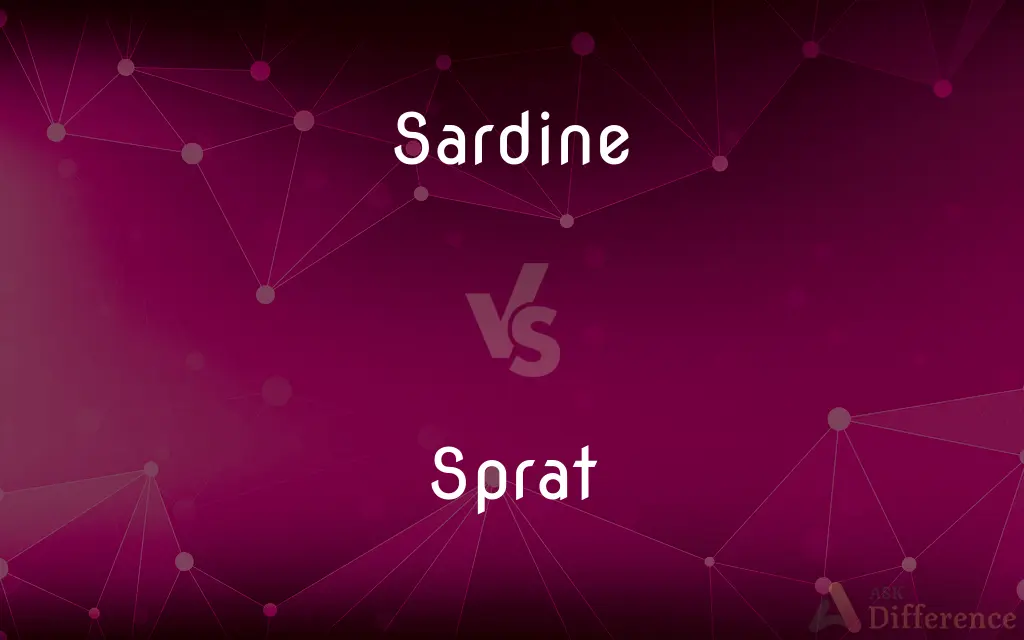Sardine vs. Sprat — What's the Difference?
By Fiza Rafique & Maham Liaqat — Updated on April 24, 2024
Sardines are typically larger and found in warmer waters, while sprats are smaller, colder water fish often confused with young sardines.

Difference Between Sardine and Sprat
Table of Contents
ADVERTISEMENT
Key Differences
Sardines are generally larger marine fish that belong to the herring family, thriving in warmer oceanic environments. Whereas, sprats are smaller and belong to a distinct genus, found predominantly in colder seas. Both types of fish are commercially significant and widely consumed, yet they inhabit different climatic zones which influence their distribution and availability.
Sardines are known for their robust size which can reach up to 20 cm in length, making them a more substantial option for canning and cooking. On the other hand, sprats are typically shorter, with maximum lengths about 12-14 cm, and are often used whole in dishes or preserved as they are less meaty.
Sardines are rich in omega-3 fatty acids, protein, and vitamins, making them a healthy dietary choice. Whereas sprats, though similar in nutritional content, may have slightly lower omega-3 levels but are still a good source of protein and minerals.
In culinary terms, sardines are versatile; they can be grilled, smoked, or preserved, showcasing their firm texture and rich flavor. On the other hand, sprats are commonly smoked or pickled, and due to their smaller size and milder flavor, they are less versatile in cooking but favored in certain traditional European dishes.
The fishery practices for sardines involve both wild capture and aquaculture with methods like purse seining and trawling. In contrast, sprats are primarily caught in the wild using similar methods, but their smaller size often dictates less intensive fishing practices.
ADVERTISEMENT
Comparison Chart
Size
Up to 20 cm
Up to 14 cm
Habitat
Warmer oceanic waters
Colder seas
Nutritional Value
Higher omega-3s
Slightly lower omega-3s
Culinary Flexibility
Versatile in cooking
Limited culinary uses
Fishing Methods
Purse seining, trawling
Mainly wild capture
Compare with Definitions
Sardine
A small, oily fish within the herring family, often canned or preserved.
Sardines are popular in Mediterranean diets due to their flavor and health benefits.
Sprat
A small fish from the Clupeidae family, similar in appearance to sardines but smaller.
Sprats are often mistaken for young sardines due to their size.
Sardine
Known for being rich in nutrients like omega-3 fatty acids.
Sardines serve as an excellent source of omega-3 which is good for heart health.
Sprat
Caught in colder waters, predominantly in the Baltic and North Seas.
The majority of sprats are harvested from the cold waters of the Baltic Sea.
Sardine
Available fresh, canned, or preserved with different preparations.
Preserved sardines can be found in most grocery stores.
Sprat
Less versatile than sardines but important in regional dishes.
Sprats are a key ingredient in some traditional Russian dishes.
Sardine
Fished commercially around the world, especially in warmer waters.
The sardine fishing industry supports many coastal economies.
Sprat
Commonly eaten smoked or pickled in Eastern Europe.
Smoked sprats are a delicacy in Baltic cuisine.
Sardine
Commonly used in a variety of culinary dishes, from grilled to smoked.
Grilled sardines are a staple in Portuguese cuisine.
Sprat
Also rich in proteins and minerals, though with slightly less omega-3 than sardines.
Despite having less omega-3, sprats are still a nutritious fish choice.
Sardine
"Sardine" and "pilchard" are common names that refer to various small, oily forage fish in the herring family Clupeidae. The term "sardine" was first used in English during the early 15th century and may come from the Mediterranean island of Sardinia, around which sardines were once abundant.The terms "sardine" and "pilchard” are not precise, and what is meant depends on the region.
Sprat
Sprat is the common name applied to a group of forage fish belonging to the genus Sprattus in the family Clupeidae. The term also is applied to a number of other small sprat-like forage fish (Clupeoides, Clupeonella, Corica, Ehirava, Hyperlophus, Microthrissa, Nannothrissa, Platanichthys, Ramnogaster, Rhinosardinia, and Stolothrissa).
Sardine
Any of various edible fishes of the family Clupeidae that are frequently canned, especially small herrings of western Atlantic waters and Sardina pilchardus of European waters.
Sprat
Any of various small marine food fishes of the genus Sprattus, especially S. sprattus of the northeast Atlantic Ocean and the Mediterranean and Baltic Seas, eaten fresh or smoked and often canned as a sardine. Also called brisling.
Sardine
Any of various other small, silvery, edible freshwater or marine fishes.
Sprat
Any of various other fishes of the family Clupeidae, such as a young herring.
Sardine
To pack tightly; cram
"The bars are sardined with hungry hopefuls" (Gael Greene).
Sprat
Any of various small, herring-like, marine fish in the genus Sprattus, in the family Clupeidae.
Sardine
Any one of several species of small herring which are commonly preserved in olive oil or in tins for food, especially the pilchard, or European sardine Sardina pilchardus (syn. Clupea pilchardus). The California sardine Sardinops sagax (syn. Clupea sagax) is similar. The American sardines of the Atlantic coast are mostly the young of the Atlantic herring and of the menhaden.
Sprat
Any of various similar fish of other genera.
Sardine
(obsolete) carnelian
Sprat
(by extension) Anything petty or insignificant.
Sardine
(figurative) Someone packed or crammed into a small space.
Sprat
A sixpence.
Sardine
To fish for sardines
Sprat
A small European herring (Clupea sprattus) closely allied to the common herring and the pilchard; - called also garvie. The name is also applied to small herring of different kinds.
Sardine
To pack or cram together tightly.
Sprat
Small fatty European fish; usually smoked or canned like sardines
Sardine
Any one of several small species of herring which are commonly preserved in olive oil for food, especially the pilchard, or European sardine (Clupea pilchardus). The California sardine (Clupea sagax) is similar. The American sardines of the Atlantic coast are mostly the young of the common herring and of the menhaden.
Sprat
Small herring processed like a sardine
Sardine
See Sardius.
Sardine
Small fatty fish usually canned
Sardine
Any of various small edible herring or related food fishes frequently canned
Sardine
A deep orange-red variety of chalcedony
Sardine
Small fishes found in great schools along coasts of Europe; smaller and rounder than herring
Common Curiosities
Are sprats available fresh or only preserved?
While often consumed preserved, sprats can also be found fresh in markets, especially in Europe.
Can sardines and sprats be used interchangeably in recipes?
Due to size and flavor differences, they are not typically interchangeable.
What are the traditional dishes that feature sardines?
Dishes like Portuguese grilled sardines and Mediterranean sardine pasta feature this fish.
What are the primary uses of sprats in cooking?
Sprats are primarily used smoked or pickled, especially in Eastern European cuisines.
What are the main physical differences between sardines and sprats?
Sardines are larger, usually up to 20 cm long, while sprats are smaller, about 14 cm.
How do the omega-3 levels compare between sardines and sprats?
Sardines generally have higher omega-3 levels compared to sprats.
What type of fishing methods are used to catch sardines?
Common methods include purse seining and trawling.
Where are sardines most commonly found?
Sardines are found in warmer oceanic regions globally.
Is there a peak season for sardine fishing?
Yes, sardine fishing typically peaks from late spring through early fall.
Are sprats sustainable seafood choices?
Yes, sprats are considered a sustainable choice due to their abundant populations and efficient fishing practices.
What are the benefits of including sardines in one's diet?
Sardines offer high levels of omega-3 fatty acids, protein, and essential vitamins.
Which countries are major producers of sprats?
Countries like Latvia and Estonia are major producers of sprats.
How should fresh sprats be prepared in cooking?
Fresh sprats are best enjoyed smoked or fried, complementing their delicate texture.
What are some health benefits of eating sprats?
Sprats are good for cardiovascular health due to their protein and mineral content.
How do the flavors of sardines and sprats compare?
Sardines have a richer, more pronounced flavor compared to the milder tasting sprats.
Share Your Discovery

Previous Comparison
Advice vs. Consultation
Next Comparison
Hillside vs. BankAuthor Spotlight
Written by
Fiza RafiqueFiza Rafique is a skilled content writer at AskDifference.com, where she meticulously refines and enhances written pieces. Drawing from her vast editorial expertise, Fiza ensures clarity, accuracy, and precision in every article. Passionate about language, she continually seeks to elevate the quality of content for readers worldwide.
Co-written by
Maham Liaqat













































